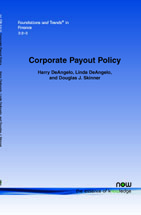Corporate Payout Policy
By Harry DeAngelo, Marshall School of Business, University of Southern California, USA, hdeangelo@marshall.usc.edu | Linda DeAngelo, Marshall School of Business, University of Southern California, USA, ldeangelo@marshall.usc.edu | Douglas J. Skinner, The University of Chicago Booth School of Business, USA, douglas.skinner@chicagobooth.edu
Abstract
We present a synthesis of academic research on corporate payout policy grounded in the pioneering contributions of Lintner (1956) and Miller and Modigliani (1961). We conclude that a simple asymmetric information framework that emphasizes the need to distribute FCF and that embeds agency costs (as in Jensen (1986)) and security valuation problems (as in Myers and Majluf (1984)) does a good job of explaining the main features of observed payout policies — i.e., the massive size of corporate payouts, their timing and, to a lesser degree, their (dividend versus stock repurchase) form. We also conclude that managerial signaling motives, clientele demands, tax deferral benefits, investors' behavioral heuristics, and investor sentiment have at best minor influences on payout policy, but that behavioral biases at the managerial level (e.g., over-confidence) and the idiosyncratic preferences of controlling stockholders plausibly have a first-order impact.
Corporate Payout Policy
Corporate Payout Policy synthesizes the academic research on payout policy and explains "how much, when, and how". That is (i) the overall value of payouts over the life of the enterprise, (ii) the time profile of a firm's payouts across periods, and (iii) the form of those payouts. The authors conclude that today's theory does a good job of explaining the general features of corporate payout policies, but some important gaps remain. So while our emphasis is to clarify "what we know" about payout policy, the authors also identify a number of interesting unresolved questions for future research. Corporate Payout Policy discusses potential influences on corporate payout policy including managerial use of payouts to signal future earnings to outside investors, individuals' behavioral biases that lead to sentiment-based demands for distributions, the desire of large block stockholders to maintain corporate control, and personal tax incentives to defer payouts. The authors highlight four important "carry-away" points: the literature's focus on whether repurchases will (or should) drive out dividends is misplaced because it implicitly assumes that a single payout vehicle is optimal; extant empirical evidence is strongly incompatible with the notion that the primary purpose of dividends is to signal managers' views of future earnings to outside investors; over-confidence on the part of managers is potentially a first-order determinant of payout policy because it induces them to over-retain resources to invest in dubious projects and so behavioral biases may, in fact, turn out to be more important than agency costs in explaining why investors pressure firms to accelerate payouts; the influence of controlling stockholders on payout policy — particularly in non-U.S. firms, where controlling stockholders are common — is a promising area for future research. Corporate Payout Policy is required reading for both researchers and practitioners interested in understanding this central topic in corporate finance and governance.
